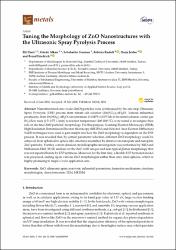| dc.contributor.author | Emil Kaya, Elif | |
| dc.contributor.author | Alkan, Gözde | |
| dc.contributor.author | Gürmen, Sebahattin | |
| dc.contributor.author | Rudolf, Rebeka | |
| dc.contributor.author | Jenko, Darja | |
| dc.contributor.author | Friedrich, Bernd | |
| dc.date.accessioned | 2021-01-08T21:51:24Z | |
| dc.date.available | 2021-01-08T21:51:24Z | |
| dc.date.issued | 2018 | |
| dc.identifier.issn | 2075-4701 | |
| dc.identifier.uri | http://doi.org/10.3390/met8080569 | |
| dc.identifier.uri | https://hdl.handle.net/20.500.12846/218 | |
| dc.description | Feizpour, Darja/0000-0003-0866-6424; Kaya, Elif Emil/0000-0002-9945-1199; Gurmen, Sebahattin/0000-0002-3830-9041; Rudolf, Rebeka/0000-0003-0510-5752; Friedrich, Prof. Dr.-Ing. Dr. h.c. Bernd/0000-0002-2934-2034 | en_US |
| dc.description | WOS:000443616400005 | en_US |
| dc.description.abstract | Nanostructured zinc oxide (ZnO) particles were synthesized by the one step Ultrasonic Spray Pyrolysis (USP) process from nitrate salt solution (Zn(NO3)(2)center dot 6H(2)O). Various influential parameters, from Zn(NO3)(2)center dot 6H(2)O concentrations (0.01875-0.0375 M) in the initial solution, carrier gas (N-2) flow rates (0.5-0.75 L/min) to reaction temperature (400-800 degrees C), were tested to investigate their role on the final ZnO particles' morphology. For this purpose, Scanning Electron Microscopy (SEM), High Resolution Transmission Electron Microscopy (HRTEM) and (Selected Area Electron Diffraction) SAED techniques were used to gain insight into how the ZnO morphology is dependent on the USP process. It was revealed that, by certain parameter selection, different ZnO morphology could be achieved, from spherical to sphere-like structures assembled by interwoven nanoplate and nanoplate ZnO particles. Further, a more detailed crystallographic investigation was performed by XRD and Williamson-Hall (W-H) analysis on the ZnO with unique and non-typical planar morphology that was not reported before by USP synthesis. Moreover, for the first time, a flexible USP formation model was proposed, ending up in various ZnO morphologies rather than only ideal spheres, which is highly promising to target a wide application area. | en_US |
| dc.description.sponsorship | Slovenian Research AgencySlovenian Research Agency - Slovenia [P2-0120, P2-0132, BI-DE/17-19-12] | en_US |
| dc.description.sponsorship | The authors would like to thank Gultekin GoLLER and Technician Huseyin SEZER for the SEM studies. The authors acknowledge the financial support from the Slovenian Research Agency (Research Core Funding No. P2-0120, P2-0132, BI-DE/17-19-12). The responsible proof reader for the English language is Shelagh Hedges, Faculty of Mechanical Engineering, University of Maribor, Slovenia. | en_US |
| dc.language.iso | eng | en_US |
| dc.publisher | Mdpi | en_US |
| dc.rights | info:eu-repo/semantics/openAccess | en_US |
| dc.subject | Zno | en_US |
| dc.subject | Ultrasonic Spray Pyrolysis | en_US |
| dc.subject | Influential Parameters | en_US |
| dc.subject | Formation Mechanism | en_US |
| dc.subject | Structure | en_US |
| dc.subject | Morphologies | en_US |
| dc.subject | Characterization | en_US |
| dc.subject | Tem | en_US |
| dc.subject | Hrtem | en_US |
| dc.title | Tuning the morphology of ZnO nanostructures with the ultrasonic spray pyrolysis process | en_US |
| dc.type | article | en_US |
| dc.relation.journal | Metals | en_US |
| dc.identifier.volume | 8 | en_US |
| dc.identifier.issue | 8 | en_US |
| dc.relation.publicationcategory | Makale - Uluslararası Hakemli Dergi - Kurum Öğretim Elemanı | en_US |
| dc.contributor.department | TAÜ, Fen Fakültesi, Malzeme Bilimi ve Teknolojileri Bölümü | en_US |
| dc.contributor.institutionauthor | Emil Kaya, Elif | |
| dc.identifier.doi | 10.3390/met8080569 | |
| dc.identifier.wosquality | Q1 | en_US |
| dc.identifier.scopusquality | Q1 | en_US |
| dc.identifier.wos | WOS:000443616400005 | en_US |

















